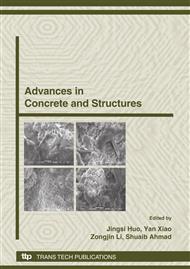p.911
p.917
p.923
p.929
p.935
p.943
p.949
p.957
p.963
Influence of Temperature on the Cracking of Reinforced Concrete Frame
Abstract:
In this paper, the influence of temperature on the cracking of reinforced concrete frame is studied. Finite element analysis software is used to simulate the concrete cracking. In the modeling process, separate model element of SOLID65+LINK8 is used. Also, the Hongestad model is applied to the stress-strain relation of concrete and the rule of BISO is applied to the stress-strain relation of steel. By comparing the stress and strain of three different structure frames before and after temperature increasing, the extending rules of concrete cracking and the stress character of beam and column are analyzed. It is found that the maximum stress of beam is located in the end of the beam-column joints and the middle of beam under the temperature action. It is suggested that they are caused by moment and axis-force respectively. However, the greatest stress of column is situated at the end of beam-column joints. The reason is that the end of beam-column joints should deform to coordinate the influence of temperature. Thus, greater peak stress is caused. So, the concrete cracking is always distributed in the middle of beam span or beam-column joints, where the position of stress concentrates. In addition, the stress of steel in beams increases greatly under the temperature load, suggesting that the temperature leads to the internal force redistribution in the concrete component and the cracking of component.
Info:
Periodical:
Pages:
963-968
Citation:
Online since:
October 2008
Authors:
Price:
Сopyright:
© 2009 Trans Tech Publications Ltd. All Rights Reserved
Share:
Citation:


